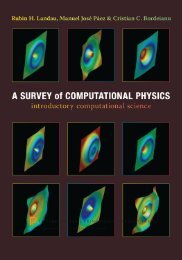Statistical Physics
Statistical Physics
Statistical Physics
- No tags were found...
You also want an ePaper? Increase the reach of your titles
YUMPU automatically turns print PDFs into web optimized ePapers that Google loves.
110 7 Magnetic Materialsdependence as that of a system of free spins in a magnetic field B = J/µ.Compare this result with that obtained from the mean-field approximation,which has a discontinuity at T c =2J/k B in the present notation.7.4.3 Magnetization and SusceptibilityHere we allow the magnetic field to have a nonzero value; that is, b = βµB ≠0.The free energy F and the magnetization M are now given by[√]F = −Nk B T ln e K cosh b + e 2K cosh 2 b − 2sinh2K (7.65)andM = − ∂F∂B = −∂F ∂b βµe K e 2K sinh b cosh bsinh b + √e= βµNk B T2K cosh 2 b − 2sinh2Ke K cosh b +√e 2K cosh 2 b − 2sinh2K . (7.66)In the limit of a weak magnetic field, sinh b ≃ b, coshb ≃ 1, andM ≃ Nµ eK +e 2K /e −ke K +e −K × b = Nµ2k B T × e2K B = Nµ2k B T e2J/kBT B. (7.67)Thus there is no spontaneous magnetization: when B = 0, M = 0. Thesusceptibility is given byχ = µ 0Nµ 2k B T e2J/kBT . (7.68)The susceptibility of a free spin system, µ 0 Nµ 2 /k B T , is enhanced by a factore 2J/kBT . The temperature dependence is shown in Fig. 7.13.The result of this exact calculation has shown that there is no phase transitionin this one-dimensional Ising model. This is a special feature of a onedimensionalsystem. The order in a one-dimensional system is quite fragilewith respect to thermal fluctuations. Since each spin has only two nearestneighbors, a flip of a single spin can cause a spin flip of a neighbor witha probability of 1/2, and so a spin flip can propagate and may cause flips ofthe majority of spins. On the other hand, propagation of a spin flip is unlikelyin two dimensions if the spins are already mostly aligned. In fact, ithas been shown that there is a phase transition in the two-dimensional Isingmodel, as we shall see in Chap. 9. The transition temperature in this case isgiven by k B T c = J/ sinh −1 1=1.13J for a square lattice. The investigation ofa one-dimensional system is sometimes fruitful, because we can obtain exactsolutions, but we must be aware that the results may be qualitatively differentfrom those for real three-dimensional systems.











![Práctica [PDF] - Universidad de Carabobo, FACYT - computacion](https://img.yumpu.com/48491415/1/190x245/practica-pdf-universidad-de-carabobo-facyt-computacion.jpg?quality=85)




